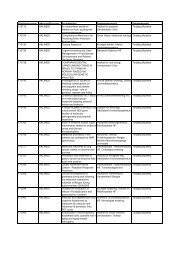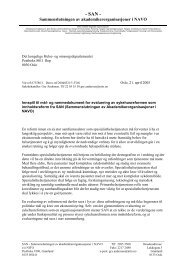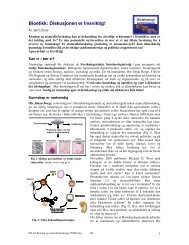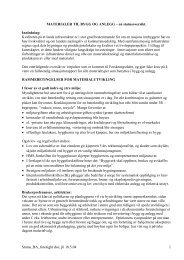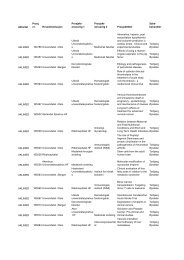A Revolution in R&D
A Revolution in R&D
A Revolution in R&D
You also want an ePaper? Increase the reach of your titles
YUMPU automatically turns print PDFs into web optimized ePapers that Google loves.
esourced <strong>in</strong> relation to the flow from upstream,<br />
and hence wasteful once aga<strong>in</strong>. It will take some<br />
adroit adjustment of resources and processes along<br />
the value cha<strong>in</strong> to restore a smooth flow.<br />
This imbalance will affect <strong>in</strong>cumbents—<strong>in</strong>tegrated<br />
companies with established value cha<strong>in</strong>s—worst of<br />
all. They have resources and processes <strong>in</strong> place;<br />
changes are likely to be difficult and disruptive. To<br />
implement the new genomics technologies is troublesome<br />
enough, but then to have to redistribute<br />
resources along the entire value cha<strong>in</strong> will take real<br />
determ<strong>in</strong>ation. (To other companies, by contrast,<br />
bottlenecks might represent very favorable opportunities.<br />
In particular, genomics companies could<br />
benefit. (See sidebar, “Upstart Start-ups—the<br />
Competitors Classified.”)<br />
The Human Factor<br />
To flourish <strong>in</strong> the new genomics era, and possibly<br />
even to survive, companies are go<strong>in</strong>g to have to<br />
engage the new realities. It will not be easy. Some of<br />
the new technologies will tend to overstretch or<br />
even defy exist<strong>in</strong>g capabilities and organizational<br />
structures. All along the value cha<strong>in</strong>, processes and<br />
resources are go<strong>in</strong>g to have to be adjusted.<br />
The resources <strong>in</strong> question <strong>in</strong>clude human resources,<br />
and retrench<strong>in</strong>g, reassign<strong>in</strong>g, or supplement<strong>in</strong>g talented<br />
personnel is a far from straightforward procedure.<br />
But it will have to be done. Organizational<br />
restructur<strong>in</strong>g is likely to entail distress<strong>in</strong>g upheavals<br />
for corporate culture and personnel alike. The<br />
strategies adopted for manag<strong>in</strong>g it will require constant<br />
monitor<strong>in</strong>g and f<strong>in</strong>e-tun<strong>in</strong>g. New modes of<br />
cross-functional collaboration may need to be <strong>in</strong>stituted,<br />
new <strong>in</strong>centives offered, and so on.<br />
I spend half my time look<strong>in</strong>g for talent that isn’t<br />
out there, and the other half worry<strong>in</strong>g where they<br />
would fit if I found them.<br />
—Research director,<br />
lead<strong>in</strong>g biotech company<br />
* * *<br />
In sum, implement<strong>in</strong>g genomics technology will be<br />
very tricky. It will almost certa<strong>in</strong>ly require a holistic,<br />
cross-value-cha<strong>in</strong> perspective. We will discuss potential<br />
solutions to these operational challenges <strong>in</strong> the<br />
third chapter.<br />
A F<strong>in</strong>al Word<br />
By engag<strong>in</strong>g affirmatively with the brave new<br />
genomics world, companies are mak<strong>in</strong>g it possible<br />
to <strong>in</strong>crease R&D productivity substantially. They will<br />
br<strong>in</strong>g to bear an array of <strong>in</strong>dustrialized processes,<br />
<strong>in</strong>formatics, and rich data sets—a formidable comb<strong>in</strong>ation<br />
that promises to boost efficiency, and even<br />
improve success rates, all along the value cha<strong>in</strong>.<br />
Here we have discussed both the opportunities and<br />
the challenges that arise when a company adopts<br />
and implements genomics technologies that are<br />
available today.<br />
The opportunities add up to potential sav<strong>in</strong>gs of<br />
nearly $300 million per drug—about one-third of<br />
the cost—and the prospect of br<strong>in</strong>g<strong>in</strong>g each drug<br />
to market two years sooner. The challenges <strong>in</strong>clude<br />
manag<strong>in</strong>g quality control and deal<strong>in</strong>g with unfamiliar<br />
operational predicaments: bottlenecks along the<br />
pipel<strong>in</strong>e and a host of organizational difficulties.<br />
But for companies that choose not to meet the<br />
genomics revolution head on, the challenge is even<br />
greater: they will be unable to compete. These companies<br />
do more than leave money on the table.<br />
They face the <strong>in</strong>evitability of be<strong>in</strong>g left beh<strong>in</strong>d.<br />
To reap maximum benefit from the new technologies,<br />
companies will need to scrut<strong>in</strong>ize their resources,<br />
processes, and policies throughout the<br />
value cha<strong>in</strong>. Pharmaceutical and biotech managers<br />
will need to ask themselves some tax<strong>in</strong>g questions as<br />
they beg<strong>in</strong> to formulate their genomics strategy:<br />
• Which specific genomics technologies and<br />
approaches make the most sense for our company?<br />
What <strong>in</strong>vestments and capabilities would be<br />
needed to <strong>in</strong>tegrate these new technologies and<br />
approaches successfully?<br />
• What capabilities do we already have? What<br />
<strong>in</strong>vestment are we prepared to make to acquire<br />
those we lack?<br />
21



